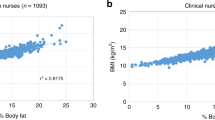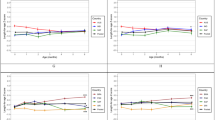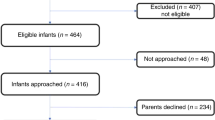Abstract
We assessed whether the earlier described ‘thin–fat phenotype’ is present in Surinam South Asian babies of the fourth to fifth generation after migration from India. In this observational study we collected data from 39 South Asian term neonates and their mothers in Paramaribo, Surinam. We compared the following data with data from an earlier study in Southampton, UK (338 neonates) and in Pune, India (631 neonates): maternal body mass index, neonatal weight, length, head, mid-upper arm and abdominal circumferences and subscapular skinfold thickness. The mothers in Paramaribo were older than the Southampton mothers; their body mass index was comparable. Mean birth weight was 3159 g (Southampton: 3494 g; Pune: 2666 g). Compared with Southampton babies, the Paramaribo babies were smaller in nearly all body measurements, the smallest being abdominal circumference at the umbilicus level (s.d. score: −1.62; 95% confidence interval (CI): −2.07 to −1.16) and mid-upper arm circumference (s.d. score: −1.08; 95% CI: −1.46 to −0.69). In contrast, subscapular skinfold thickness was similar (s.d. score: +0.08; 95% CI: −0.24 to +0.55). Except for subscapular skinfold thickness and length, all neonatal measurements were intermediate between those from Southampton and Pune. The thin–fat phenotype is preserved in Surinam South Asian neonates of the fourth to fifth generation after migration from India.
This is a preview of subscription content, access via your institution
Access options
Subscribe to this journal
Receive 12 print issues and online access
$259.00 per year
only $21.58 per issue
Buy this article
- Purchase on Springer Link
- Instant access to full article PDF
Prices may be subject to local taxes which are calculated during checkout

Similar content being viewed by others
References
Middelkoop BJC, Kesarlal-Sadhoeram SM, Ramsaransing GN, Struben HWA . Diabetes mellitus among South Asian inhabitants of The Hague: high prevalence and an age-specific socioeconomic gradient. Int J Epidemiol 1999; 28: 1119–1123.
Schaad JDG, Terpstra J, Oemrawsingh I, Nieuwenhuijzen Kruseman AC, Bouwhuis-Hoogerwerf ML . Diabetes prevalence in the three main ethnic groups in Surinam (South-America): a population survey. Neth J Med 1985; 28: 17–22.
Yajnik CS, Janipalli CS, Bhaskar S, Kulkarni SR, Freathy RM, Prakash S et al. FTO gene variants are strongly associated with type 2 diabetes in South Asian Indians. Diabetologia 2009; 52: 247–252.
Barker DJP . Maternal nutrition, fetal nutrition, and disease in later life. Nutrition 1997; 13: 807–813.
Yajnik CS . Early life origins of insulin resistance and type 2 diabetes in India and other Asian countries. J Nutr 2004; 134: 205–210.
Schulpen TWJ . Mortaliteitsverschillen tussen allochtone en autochtone kinderen in Nederland (Mortality differences between migrant and indigenous children in the Netherlands). Center for Migration and Child Health: Utrecht, 1996 (in Dutch).
Yajnik CS, Fall CHD, Coyaji KJ, Hirve SS, Rao S, Barker DJP et al. Neonatal anthropometry: the thin-fat Indian baby. The Pune Maternal Nutrition Study. Int J Obes 2003; 27: 173–180.
Yajnik CS, Lubree HG, Rege SS, Naik SS, Deshpande JA, Deshpande SS et al. Adiposity and hyperinsulinemia in Indians are present at birth. J Clin Endocrinol Metab 2002; 87: 5575–5580.
Chandieshaw PK . Diabetic Nephropathy in Surinamese South Asian Subjects. Thesis, Leiden University, Leiden, The Netherlands, 2008.
Choenni CES, Adhin KS . Hindostanen: Van Brits-Indische emigranten via Suriname tot burgers van Nederland (South Asians: From British-Indian emigrants via Surinam to citizens of the Netherlands). Sampreshan: The Hague, 2003 (in Dutch).
Acknowledgements
We thank the Dutch Diabetes Research Foundation for support for this work. We are grateful to all the patients and their families who participated in this study. We also thank the gynecologists, medical students and nurses from ‘s Lands Hospitaal and Diakonessenhuis for their support.
Author information
Authors and Affiliations
Corresponding author
Rights and permissions
About this article
Cite this article
van Steijn, L., Karamali, N., Kanhai, H. et al. Neonatal anthropometry: thin–fat phenotype in fourth to fifth generation South Asian neonates in Surinam. Int J Obes 33, 1326–1329 (2009). https://doi.org/10.1038/ijo.2009.154
Received:
Revised:
Accepted:
Published:
Issue Date:
DOI: https://doi.org/10.1038/ijo.2009.154
Keywords
This article is cited by
-
Ancient origins of low lean mass among South Asians and implications for modern type 2 diabetes susceptibility
Scientific Reports (2019)
-
Developmental undernutrition, offspring obesity and type 2 diabetes
Diabetologia (2019)
-
Relation between body composition at birth and child development at 2 years of age: a prospective cohort study among Ethiopian children
European Journal of Clinical Nutrition (2017)
-
Failing beta-cell adaptation in South Asian families with a high risk of type 2 diabetes
Acta Diabetologica (2015)
-
Vitamin B12: one carbon metabolism, fetal growth and programming for chronic disease
European Journal of Clinical Nutrition (2014)



